Alice De Courcy, CMO of Cognism, one of the leading Sales Intelligence platforms, sat down recently with our very own CMO, Declan Mulkeen to talk all things ABM - its past, its present and its future.
There is no denying that working for an ABM Agency gives us a unique window into the world of Account-based Marketing.
Working with clients across a multitude of industries - from MarTech to FinTech, from CyberTech, to HRTech, and with different levels of ABM maturity means we get to see ABM in action - in real life and not in a laboratory.
We get to see what works. We get to see what really moves the dial.
We’re all about sharing, so here are two CMOs talking all things ABM.
Two CMOs talk ABM
Alice started at the top by answering a question: What is ABM?
This question is a simple but important one, as the answer varies greatly depending on who you ask.
There are plenty of voices in the world of B2B marketing who have their own opinion and definition for ABM - but here’s our stance...
Q What is (and isn’t) ABM?
A If you go back to the pure definition of ABM, which dates back practically 20 years - back to 2003 - ABM in its purest sense is a strategy that treats an account, or a cluster of accounts, as a market of one.
Another way to think about ABM is that it is a means of looking at one account or a group of accounts that have similarities – for example, business challenges, they belong to the same vertical, etc.
ABM is a highly personalized strategy where you harness data, insights, and technology to build a unique account experience to develop relationships, build a reputation, and ultimately drive revenue.
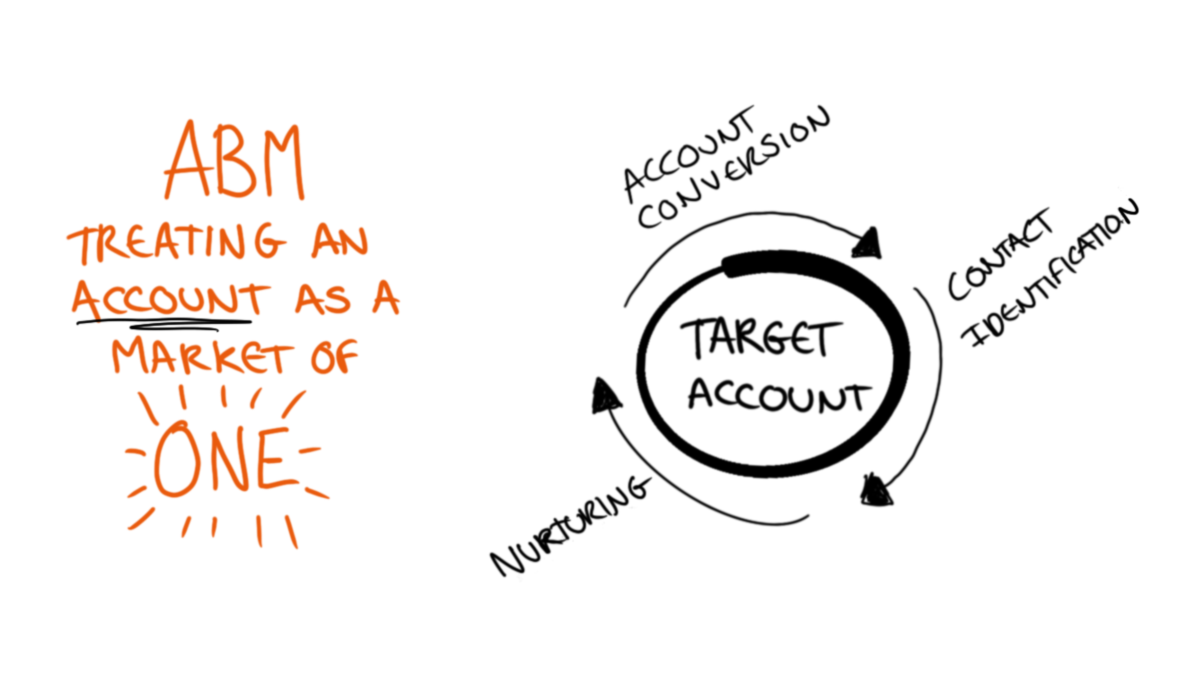 Q Who is ABM a good fit for?
Q Who is ABM a good fit for?
A There are certain criteria you can use to determine whether ABM is a good fit for your business, for example:
- You're selling a high-value/complex solution into B2B Enterprise or mid-market.
- The solution/product that you have has a long sales cycle.
- You are reaching a level of maturity in your Marketing and Sales that you're actually able to take on what can be quite a resource-heavy marketing strategy.
- You are looking to target a buying committee
So typically, if you are selling a high-value item into an organization, a complex software solution, cloud infrastructure or cybersecurity, etc., undoubtedly you're going to be talking to many people in the organization within the IT team, within the Procurement team, very often in the C-suite - right up to the CEO.
So you need to be able to influence multiple groups of people – what we tend to call a buying committee.
Conversely, you're not ready for ABM if:
- You’re still at the product-market fit stage. You should still work on your brand. You should work on Demand Gen, etc.
- You have a low average deal value. Typically, average annual contract value (ACV) of circa $50,000. Anything below that, and ABM is probably not the best fit for you because of the level of investment required.
- You’re not targeting mid-market and/or enterprise accounts.
- Your organization is much more of a Sales organization and you don't yet have that Marketing function properly defined. If you don't have a good marketing infrastructure that is actually able to support and run these ABM programs, ABM is not likely to be a good fit.
A discussion: Is ABM just good B2B marketing?
Alice
There's a lot of chatter about it - I think a lot of people are like, “Oh, we're doing ABM”, but actually they're not really doing ABM.
Declan
Over the course of the last five, six, seven years there have been many companies that have launched themselves into the ABM world.
And very often when we ask prospects and the wider community about their ABM programs, they may say “I'm running some LinkedIn ads.” And that's their definition of ABM.
Or they may say, “Yeah, we do ABM”. And we dig a little bit deeper and ask more questions, and they say, “well, we're running direct mail”.
Those are tactics that can form part of an ABM strategy, but they're just tactics.
I think what's happening is, people are grappling with the concept of ABM and trying to understand it. They're picking certain elements that can often form part of a wider ABM strategy.
But I think they're missing the bigger picture that ABM is for us and our clients. It is very much a strategic pivot for the whole organization.
Alice
It goes back to that whole point of some people thinking ABM is just good B2B marketing. Well, it's not, but it depends if you're actually doing proper ABM.
But because of this, people are more aware of how we should be marketing, regardless of whether your deal size is under $40,000. So using more, looking at accounts, and focusing your targeting better through multiple channels.
And so they think they're doing ABM, but they're actually just doing better B2B marketing, which is a good thing, right?
Declan
I think the difference between B2B Demand Gen and ABM is that, as a Marketing team, you can do a great Demand Gen program almost on your own.
But ABM requires many actors to be involved - there are so many roles involved in it, and it touches many parts of our organization.
The movement now from ABM through to what some people define as ‘Account-based Experience’ or ‘Account-based Engagement’, or what we often refer to as ‘Account-based Everything’ - is when you see it actually being much more pervasive and penetrating the entire organization.
Q Who is ABM a good fit for?
A Firstly, the advice we say to everyone is to start small. Very often we say to clients that the best way to move forward with their ABM program and ABM strategy is to select a very limited number of accounts.
Secondly, it’s important to select the right ABM program based on your objectives and resources.
One-to-many
Typically, this program is used to target a relatively large number of accounts, which can be in the dozens or hundreds, or even thousands.
Personalization at this level is very light touch. It's basically trying to put a message into a set of accounts that meet your Ideal Customer Profile (ICP), with the goal of raising brand and proposition awareness.
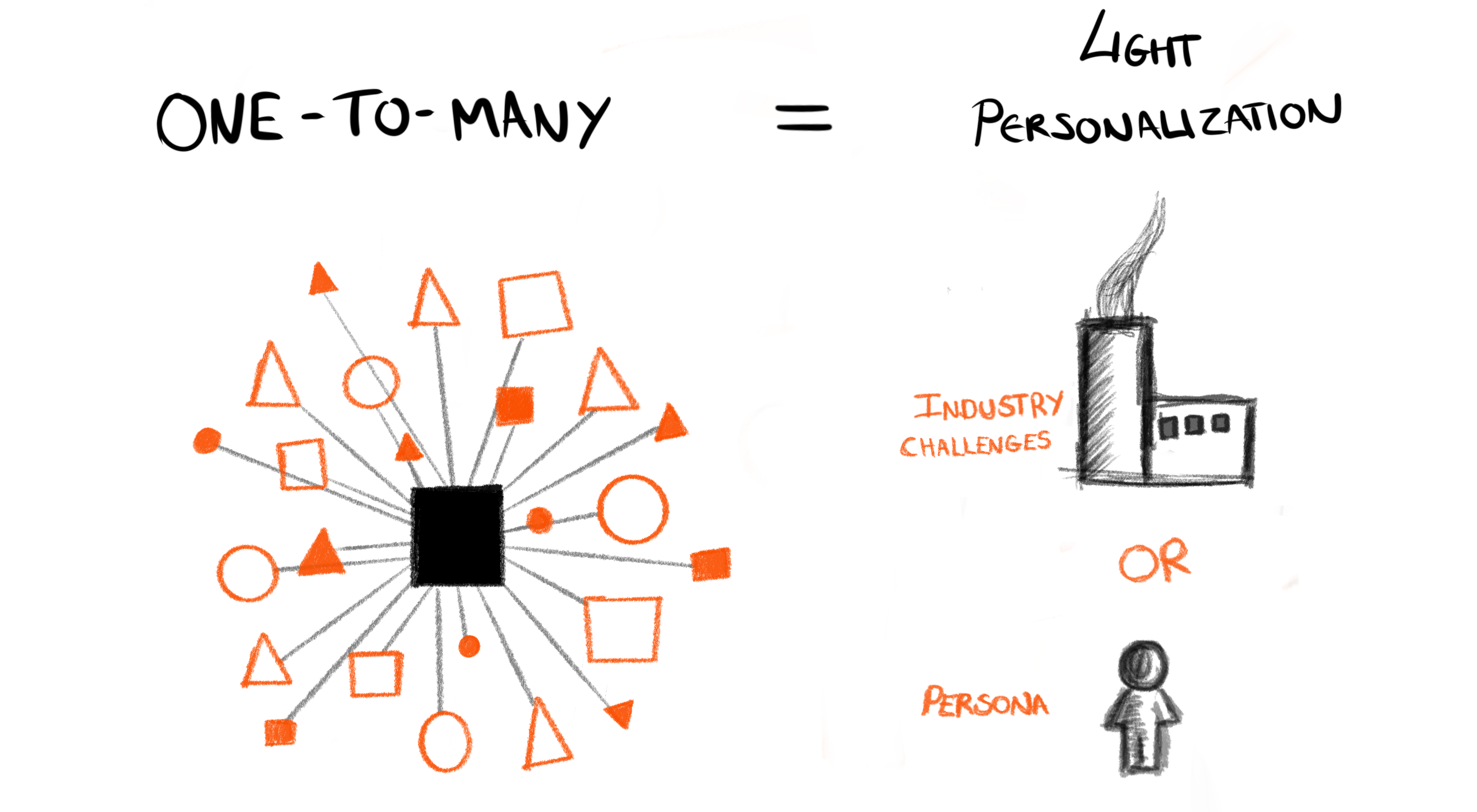
One-to-few
At this level, you take a select number of accounts. We suggest taking 15-20 accounts that warrant that extra level of investment, per quarter, and enrolling them into a One-to-few program.
For this program, the level of personalization increases. We would typically suggest upping the level of personalization to around 15 to 20% for a cluster of accounts.
So whereas the One-to-many is much more around the value proposition and what that value proposition means to that vertical or challenge, the One-to-few is where you're personalizing much more to the individual account and to the level of 15-20%, so the account is seeing something which is relevant to them.
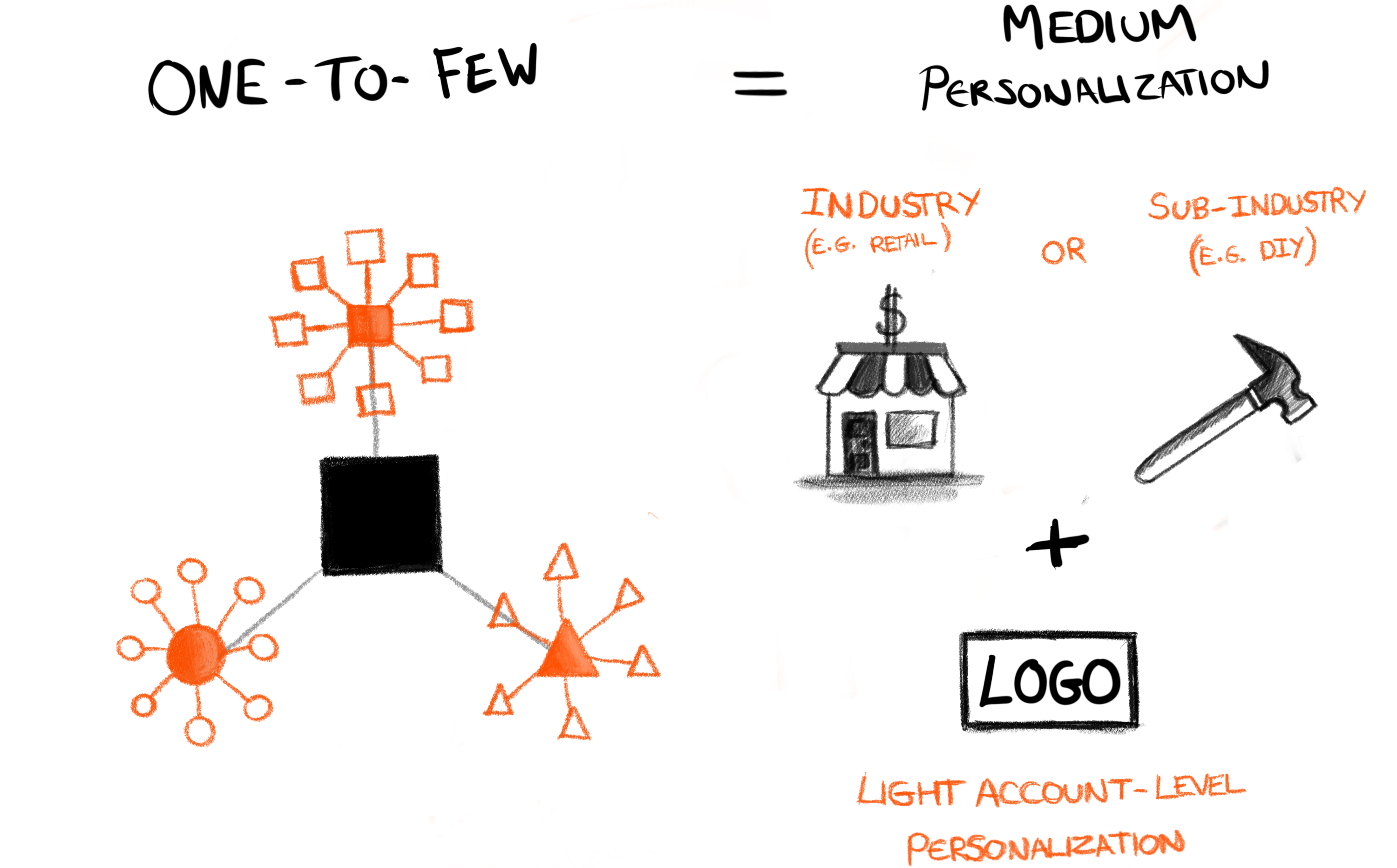
One-to-one
This is where you're going for full-scale personalization to one or a handful of accounts. It’s a far more advanced play and it's something that we would not recommend to clients to engage in as a first step into ABM.
We would recommend that clients start with what we typically call a Blended ABM program; combining a One-to-many, ‘always on’ campaign, and then choose a number of accounts from that Total Addressable Market (TAM) for a more personalized One-to-few program.
This way you're starting to drive a lot more engagement, whilst looking for those sales triggers. Looking for when they are exhibiting some level of intent, some level of engagement with your brand, some level of engagement with the content that you're pushing out there.
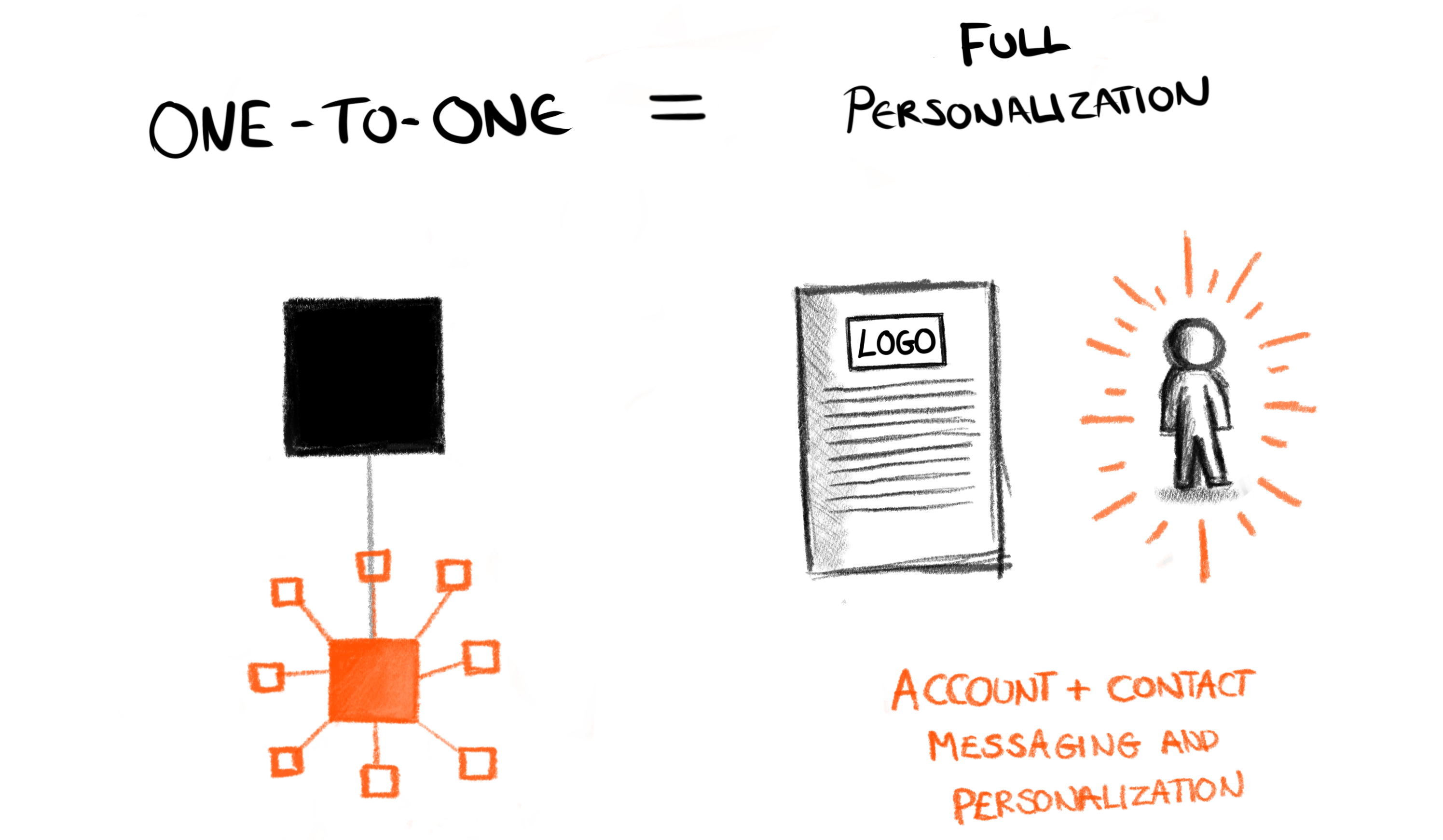
Q How do you structure a Marketing team for ABM?
A ABM is a resource-heavy strategy in terms of all the moving parts. There is a lot of orchestration to be done and companies don't always have the people to deliver this strategy.
We often find that the Marketing teams we work with are able to pull on different parts of the Marketing organization, whether it's Design teams, Operations teams, or Content Marketing teams.
They're able to pull resources from within their wider organization to actually help to orchestrate those various elements.
We also find that, although our clients may not have anybody who's an ABM specialist within the company, over the course of working with ourselves over 12 -18 months, very often somebody becomes identified as the ABM champion within the team, and ultimately then becomes that ABM Manager or ABM Director.
It’s like an evolution that happens very often within the Marketing department that the team or individuals go through the training with ourselves to build a level of expertise and domain authority.
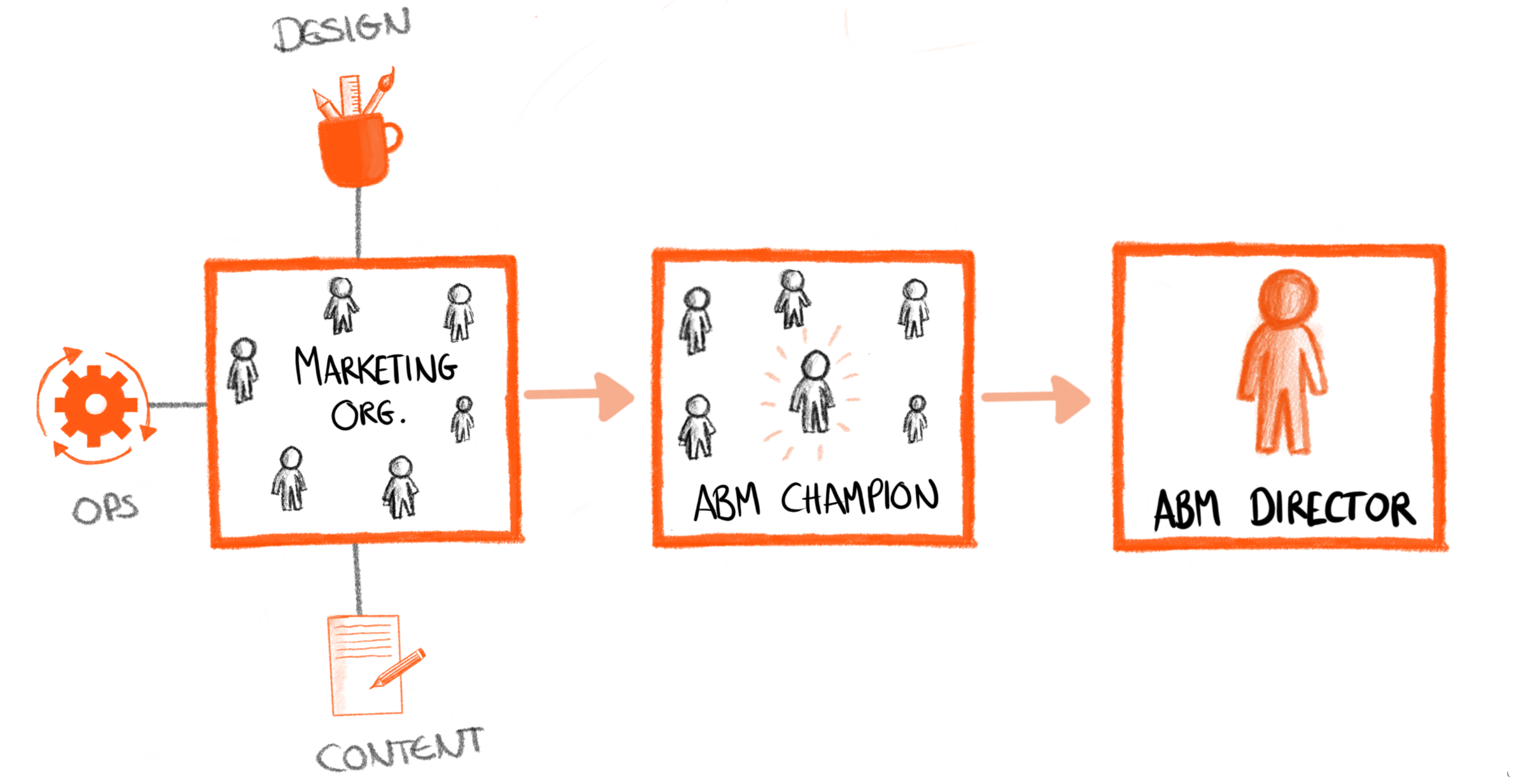
Q What are the most common mistakes companies make with ABM?
A We often talk about ABM being a journey – it's a marathon and not a sprint.
And often people might rush some of the foundational elements of that journey because they desperately need to get to campaign. Obviously, as Marketers, we’re always under pressure to get to the campaign.
We're always under pressure from the wider organization to get results as soon as possible, to show we’re moving the dial. The issue with ABM is there is a fair amount of foundational work to be done first.
And that's one of the places where we see companies perhaps not getting ABM right from the beginning.
The three most common mistakes we see are:
1. ICP Development
Not working hard enough on building your Ideal Customer Profile (ICP) and truly understanding who your ideal customer is, is a common issue.
ICP development is a collaborative approach where Marketing needs to work very closely with Sales, but also ask some questions higher up and engage with forward-thinking C-suite members.
Asking questions like "Where are we heading with our clients?" and "What kind of clients are we looking to onboard?"

2. Account Selection
We also see companies go wrong in how they're selecting accounts.
Very often, there isn't enough thought process in terms of how the accounts are being selected.
It could be the accounts have been handed down from above, or the Sales team have identified, or to be honest, a list has been cobbled together by a group of people and it's like a list of some really nice logos.
This type of account selection is likely based on a feeling that these are interesting companies, but there isn't enough (or any) science or data behind the account selection.
So we work really hard with clients on the whole account selection process.
In terms of building your Total Addressable Market (TAM), work out which accounts within that TAM you should be going after.
And then once you've done the theory process, then you've got to prioritize those accounts.
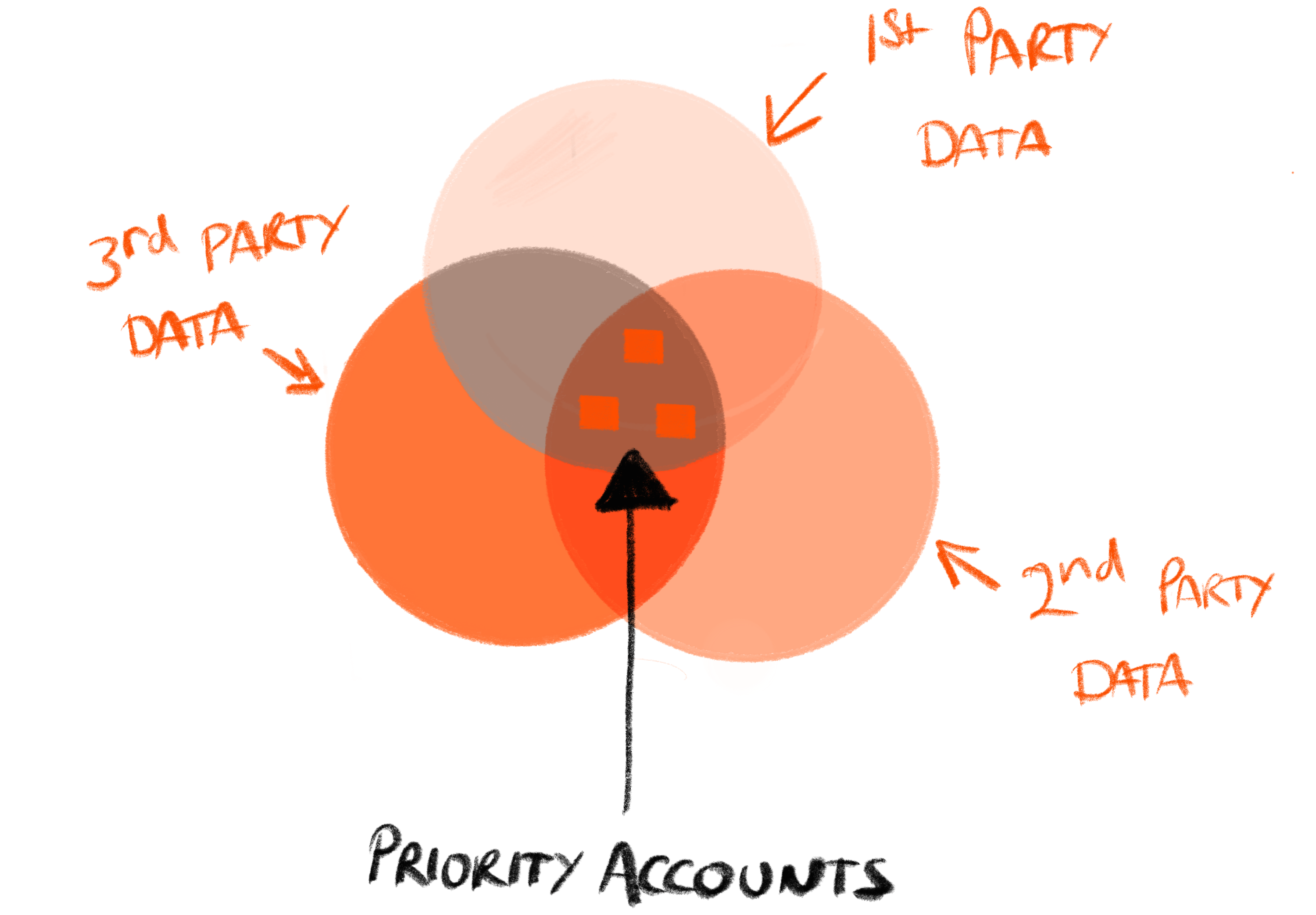
3. Sales Alignment
And then the classic one, particularly from an ABM point of view, is the relationship between Sales and Marketing. ABM is just good marketing without Sales alignment.
If you have that Sales alignment, your ABM will succeed and without it, it won't succeed or it won't be as effective.
Our discovery calls and ABM Lunch and Learn workshops sessions - here we bring Marketing and Sales teams together to talk about what they're trying to achieve.
We try to make sure that Sales is in from the very beginning, because if Sales is on board from the beginning, you're going to have success.
I think those three things are definitely where I'd say companies should look very closely.
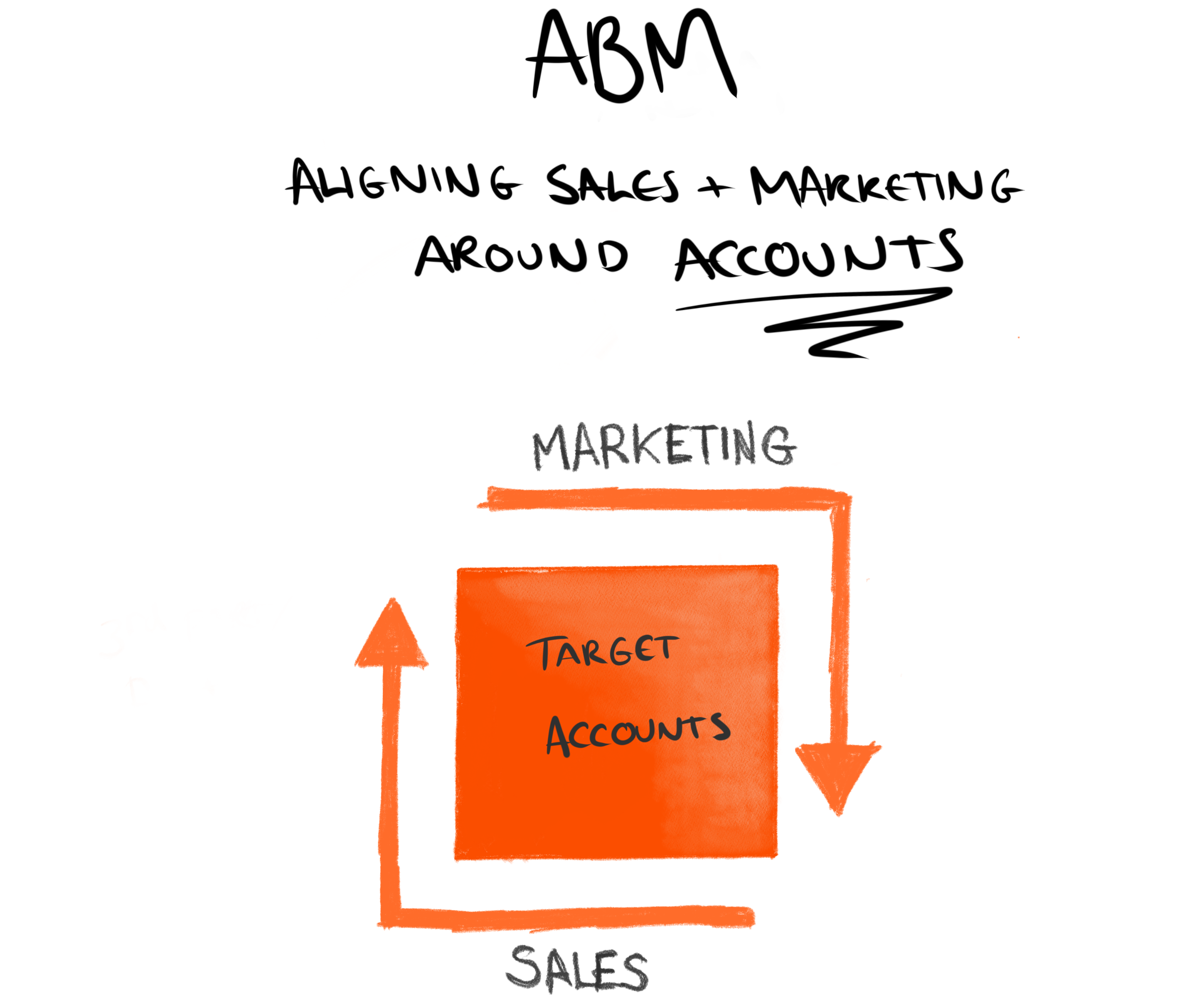
Q What are your tips for Sales alignment?
A Part of the problem is that the traditional relationship between Sales and Marketing departments can be quite siloed.
ABM is a strategic pivot for an organization. So the way we recommend our clients to talk about ABM internally is to refer to it as an Account-based strategy.
Account-based Marketing is probably the greatest unifier that exists between Sales and Marketing because you are unifying around a group of named accounts.
So once you actually bring that into a Sales meeting, you tell Sales, “hey, guys, we're going to help you work on these accounts and we're going to do everything in our power to get these accounts to move through the different deal stages and in order to obviously convert, to win, to grow or to retain those accounts that you're working on”, that then makes Sales prick up their ears.
And they actually say “you know what, you guys are actually now finally speaking our language.”
You're no longer coming to us with MQLs and SQLs and all these other Marketing acronyms that we've created over the years, that haven't really done us any favors.
And I think ABM is that great unifier.
So I would urge Marketing leaders when they're talking to their Sales colleagues to actually use the same language that Sales use.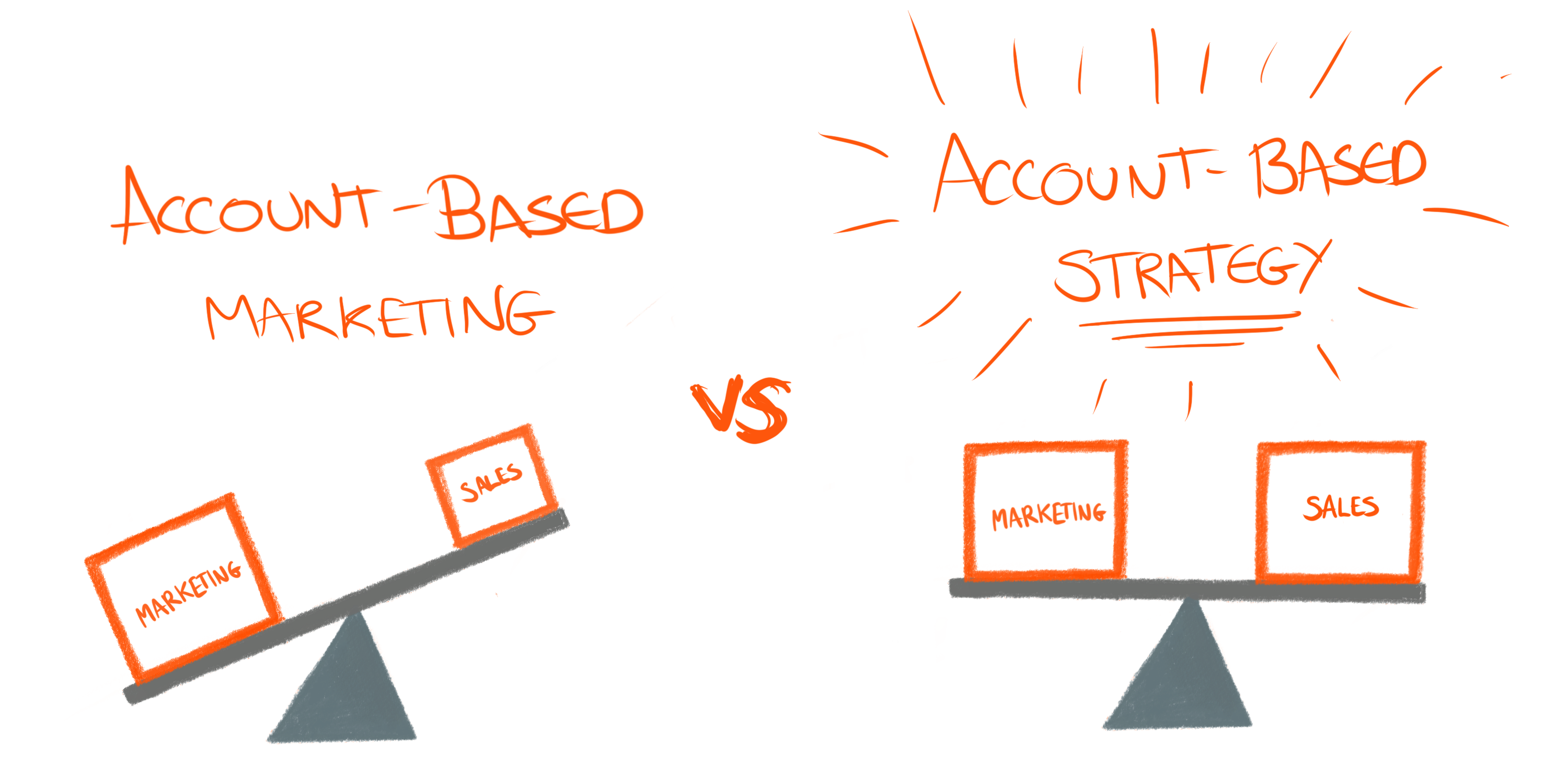
Q What is the skillset of an ABM marketer?
Be curious
Curiosity is probably the first trait or characteristic you need.
- Constantly look at your clients
- Constantly look at the market that they're operating in
- Constantly ask questions about what is happening in that market
You almost need to get to know the client more than the client knows themselves. Because the campaigns that you need to run from an ABM point of view, you're looking to change perceptions.
You're looking to penetrate accounts, you're looking to pursue major opportunities within those accounts.
To be able to actually know what will resonate, what value proposition is going to work, what type of accounts experience is going to make that impact, what data you can pull upon in terms of the intent data you're seeing, your first-party data in your database, your second-party data in terms of people that are visiting your website, third-party data in terms of the data platforms that you're using, to see what's actually happening in the market.
So you've got to be incredibly curious to know what's going on and ask a lot of questions to actually find out what you can do to move the dial.
Commercial acumen
This is not necessarily a trait that is normally required of Marketers. You need to be able to be involved in Sales.
There's such a high level of Sales engagement here and Sales enablement, that having some commercial acumen is definitely a huge advantage for ABMers.
One of the things that we advise our clients to do is to create Account Playbooks that are designed for the Salespeople to use to run their ABM campaigns, from a Sales point of view.
So the Marketing people that are creating these Account Playbooks have to really understand Sales because they have to understand Sales messaging.
They have to understand Sales outreach in terms of telephone calls, scripts, Sales messaging for emails, and Sales messaging for Social.
We're moving to a world where, regardless of whether you're looking to do ABM as a marketer, you need to have that commercial side and be very commercially aware - that's how you're going to end up getting a seat at the table, having more meaningful conversations with your leadership.
Q What tech would you recommend?
A The issue is that there is too much technology out there.
One thing that we're seeing is that very often people are leading with technology from an ABM point of view rather than leading with the strategy.
We actually advise clients and the wider ABM community to pare back on technology in the first instance, think much more about the strategy first, get that right, and then you can work out as a second level, what technology you should be using and purchasing.
When you have too much technology, you're not really exploiting any of them properly.
Every Marketing department has got a CRM, whether it's Salesforce, Marketo, HubSpot - all of them now have some form of ABM functionality.
So look at your CRM platform, try not to go any further than that at the first port of call.
Secondly, consider intent data. Again, your CRM will likely hold first and second-party intent data, and then potentially use a platform for third-party rather intent data for market insight.
And then you've obviously got marketing automation platforms of which there are many out there.
It's a case of just taking a crawl, walk, run approach.
So take technology with a degree of caution at the beginning and try to build it up slowly.








